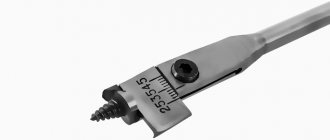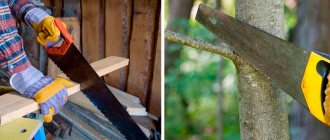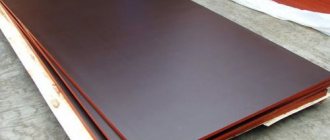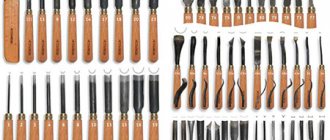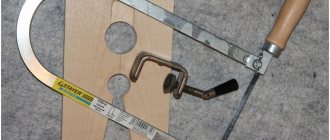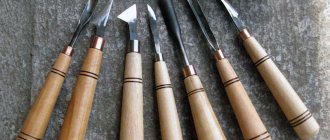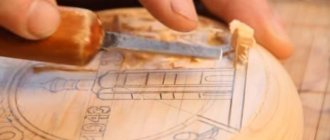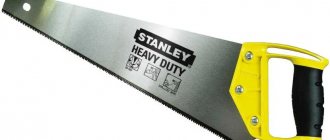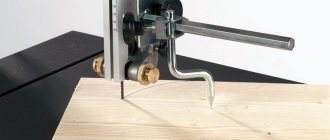To drill holes in products made of wood, you can use tools of various types, differing in design, material of manufacture and geometric parameters. One of these tools is a feather drill for wood, the design features and technical characteristics of which are worth dwelling on in more detail.
Feather drills differ in the shape of the cutting part and the sharpening of the blades
When do you need a special tool for drilling wood?
The question of how and what is the best way to drill a hole in a product made of chipboard, MDF, plywood or solid natural wood is relevant not only for carpentry specialists and those who professionally make furniture, but also for home craftsmen who prefer many jobs around the house do it yourself. The choice of drills for wood in such cases is made depending on what type of holes need to be drilled:
- blind, without an exit from the opposite side of the product (intended for mounting hinges on interior doors or on doors that are equipped with furniture structures);
- through (threaded connection elements (bolts and studs) are placed in them; without such holes it is impossible to install door handles and locks).
The main purpose of feather drills is to quickly make through holes of small depth. When drilling blind holes, be aware of the protruding tip of the drill bit.
For woodworking, you can purchase an expensive tool (such as a disk cutter). However, its use is not justified in all cases. For most situations where wood needs to be drilled, a tool that is easier to use and significantly less expensive will do the job. These are, for example, feather drills, which, despite their affordable cost, are highly efficient in use. A wood drill bit can be used in combination with either an electric drill or a regular screwdriver.
Main characteristics
When using pen drills for wood, it is advisable to know how they differ from other types of cutting tools and what advantages they have.
Comparison with other types of instruments
Like metal drills, tools designed for woodworking are available in various designs and, accordingly, differ from each other in characteristics and functionality. When choosing such tools, you should have an idea of the advantages and disadvantages they have.
Table 1. Comparison of different types of wood drills
Feather drills, as can be seen from the table presented, have a number of advantages when compared with other types of tools. Meanwhile, a pen-type tool is not recommended for making large-diameter holes (more than 60 mm), since their edges may turn out torn. For such purposes, it is better to use core drills, which are made in the shape of a metal cup with cutting teeth located on its end part.
A pen with a threaded tip is more suitable for working on a machine: it drills faster, but the hole may end up oval-shaped if the part is not secured with clamps
Due to the low cost of feather drills for wood, any home craftsman can purchase a set of them. Having such a set in your home workshop makes it easy and quick to select a tool for drilling holes of different diameters.
Design Features
The tip drill has a very simple design, the elements of which are the working and tail parts.
Feather drill design
The working part is a flat blade, in the center of which there is a sharp protrusion used to center the hole being made. On the working part of the pen drills there are two cutting blades located on either side of the central protrusion. Each of these blades starts from the tip of the central protrusion and reaches one of the edges of the working part. The tilt of sharpening the blades of feather drills for wood, if you look at their working part in cross section, is done to the right. When making drills of this type, manufacturers adhere to certain ratios between the thickness and width of the cutting part.
Table 2. The ratio of the thickness and width of the cutting element of the drill
The tail part is made in the shape of a hexagon. This cross-sectional shape allows not only to securely fix the tool in the chucks of drills and screwdrivers, but also to use magnetic adapters and extensions for these purposes.
The simplicity of the design, which distinguishes drills related to pen drills, the absence of spiral grooves, ribbons and other complex elements, are not indicators of the low efficiency of this tool.
Spade drills with two scorers enter the wood more smoothly and leave fewer burrs along the edges of the holes.
Recommendations for selection When
choosing a spade drill designed for woodworking, you should pay attention to several parameters:
- correctness of shape (wood drill feathers located on the right and left sides of the central protrusion must be symmetrical and identical in their linear dimensions);
- degree of sharpness of the cutting part (sharpening of new pen drills must be carried out in the factory and meet standard requirements);
- absence of visible defects (if the surface of a new drill contains visible defects of various types, this is a clear indicator of the low quality of such a product, most likely produced in artisanal conditions);
- color (by the color of the metal you can determine the types of additional processing to which the finished product has been subjected).
Table 3. Influence of manufacturing technology on the color of the drill bit
Tool structure
The feather drill has a simple design. The tool consists of two parts:
- Working. It is a flat blade equipped with a special rigid protrusion in the center. During the drilling process, it performs alignment. The working part is also equipped with two cutting blades, which are located on both sides of the protrusion. The sharpened cutting edge extends from the tip of the protrusion to the edge of the working part of the drill. The tool has a right- or left-hand sharpening inclination. These attachments perform drilling in one direction. For such a cutter, a sharpening angle of 75-90 degrees is provided. There are also double-sided nozzles, the cutting angle of which is 120-135 degrees.
- Tail. The cross section has a hexagonal shape, thanks to which the drill is securely fixed in the chucks of a drill and screwdriver. In addition, the attachment can be installed in magnetic adapters and extensions.
Operating rules
To increase the efficiency of using pen drills for wood and extend their service life, when performing processing, you must adhere to the following recommendations.
- Markings must be applied to those areas of the product where future holes will be located.
- For equipment that will be used in conjunction with a pen drill, it is better to choose a drill with a power regulator.
- Drilling wood using feather drills is performed at a low rotation speed (200–500 rpm). The specific value of the drill rotation speed depends on the diameter of the hole being made: the larger it is, the slower the tool should rotate.
- When the length of the pen drill is not enough to make a deep hole, special adapters are needed that are installed in the chuck of the equipment used. Otherwise, such an adapter is not required.
- Before starting drilling, the tool is brought to the surface to be processed strictly at an angle of 90°, while its sharp protrusion should be located exactly in the center of the future hole.
- Drilling should begin at low speeds, and as the drill deepens into the wood, the rotation speed can be increased.
- Chips that accumulate in the hole being created must be periodically removed from it. As soon as you notice that too many chips have accumulated, you need to stop drilling, remove the drill from the hole and remove the processing waste.
- As soon as the tool is immersed in the hole being created to the required depth, the drilling process can be stopped.
How to use the nozzle?
After purchasing a set of feather drills, you need to select a nozzle of the desired diameter from the package. It is recommended to use this cutting tool following the step-by-step instructions:
- Before drilling a hole in a wooden surface, it must be marked. The mark is applied at the point where the hole will be.
- Experienced craftsmen recommend working with these drills using a drill that has a power regulator. It is desirable that the power tool used can perform 200-500 revolutions. If it is necessary to cut a hole of a larger diameter, the number of turns should be small. Judging by consumer reviews, a 50 mm wood drill bit will cope with its task much more effectively at low speeds. As the diameter decreases, the speed increases accordingly.
- To make a deep hole, it is recommended to equip the drill chuck with a special adapter. In the event that it is necessary to drill to a small depth, the master can immediately fix the cutting attachment in the power tool.
- Bring the power tool with the attachment to the place where you will be drilling. The drill must be positioned perpendicular to the marking.
- Start working, gradually increasing the speed. It is recommended to periodically remove the drill from the hole. This requirement is due to the fact that as the wood goes deeper, chips accumulate. By removing the drill, the master thus creates an opening for wood waste to exit.
- The work is considered completed if the cutting tool has gone deep to the mark required by the master.
How to sharpen feather drills
Unlike other types of drilling tools, pen drills designed for woodworking are quite easy to sharpen. To perform this procedure, you can use a sharpening machine equipped with a diamond wheel. If such equipment is not at your disposal, a quality rule will do. The sharpening procedure itself is as follows.
- If the craftsman has a set of feather drills, a new, unused tool is taken from it, which will act as a sample.
- Focusing on the geometric parameters of the sample, sharpen the cutting part of the dull drill.
- When sharpening a pen drill for woodworking, you should be very careful not to accidentally damage its central protrusion.
It makes no sense to sharpen feather drills in cases where their cutting part is sharpened too much. Given their low cost, it is easier to replace heavily worn-out products with new ones than to try to return them to working condition.
